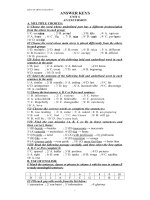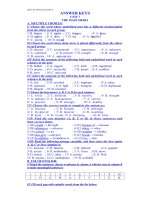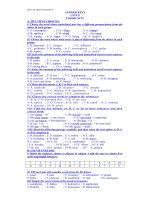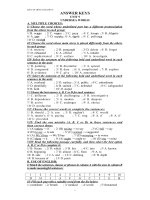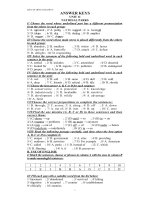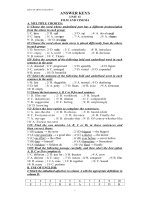JAVA EXAMINATION (include answer)
Bạn đang xem bản rút gọn của tài liệu. Xem và tải ngay bản đầy đủ của tài liệu tại đây (80.72 KB, 14 trang )
JAVA EXAMINATION
Testing duration: 60 minutes
Required score: 40
Question 1: What is the correct ordering for the import, class and package declarations when found
in a single file?
A. package, import, class
B. class, import, package
C. import, package, class
D. package, class, import
Question 2: Which methods can not be legally applied to a string object?
A. equals(String)
B. equals(Object)
C. trim()
D. round()
Question 3: What will be the result of compiling the following code:
public class Test {
public static void main (String args []) {
int age;
age = age + 1;
System.out.println("The age is " + age);
}
}
A. Compiles and runs with no output
B. Compiles and runs printing out The age is 1
C. Compiles but generates a runtime error
D. Does not compile
Question 4: Suppose we try to compile and run the following
public class Test{
public static void main(String arg[]){
int j;
for(int i = 10, j = 0; i > j; j++){
i = i -1;
}
//Statement can go here
}
}
Which of the following statements about this code are correct?
A. The loop initializer uses the correct form to set value of i and j
B. The loop initializer is not legal and code will not compile for that reason
C. If we put the following statement after the loop, it would report “i = 5 j = 5”
System.out.println(“i = ” + i + “ j = ” + j);
D. If we put the following statement after the loop, it would report “j = 5”
System.out.println(“ j = ” + j);
Question 5: Which of these is the correct format to use to create the literal char value a?
A. ‘a’
B. "a"
C. new Character(a)
D. \000a
Question 6: What happen when we try to compile and run code containing the following lines?
String s = “12345”;
String t = new String(s);
if(s == t then) System.out.println(t + “==” + s);
else System.out.println(t + “!=” + s);
A. The compiler objects to the use of == with reference variables in line 3
B. The program compiles an prints “12345=12345”
C. The program compiles an prints “12345!=12345”
D. A runtime exception occurs in line 3
Question 7: What is the legal range of a byte integral type?
A. 0 - 65, 535
B. (–128) – 127
C. (–32,768) – 32,767
D. (–256) – 255
Question 8: What will be the result of compiling the following code:
public class Test {
static int age;
public static void main (String args []) {
age = age + 1;
System.out.println("The age is " + age);
}
}
A. Compiles and runs with no output
B. Compiles and runs printing out The age is 1
C. Compiles but generates a runtime error
D. Does not compile
Question 9: Which of the following is illegal
A. int i = 32;
B. float f = 45.0;
C. long l = 40;
D. double d = 45.0;
Question 10: Which assignments are illegal?
A. float f = -412;
B. double d = 0x12345678;
C. short s = 10;
D. int other = (int)true;
Question 11: Which of the following represents an octal number?
A. 0x12
B. 32O
C. 032
D. (octal)2
Question 12: Which of the following are acceptable?
A. Object o = new Button("A");
B. Boolean flag = true;
C. Panel p = new Frame();
D. Frame p = new Applet();
Question 13: What is the result of compiling and running the following code:
public class Test {
static int total = 10;
public static void main (String args []) {
new Test();
}
public Test () {
System.out.println("In test");
System.out.println(this);
int temp = this.total;
if (temp > 5) {
System.out.println(temp);
}
}
}
A. The class will not compile
B. The compiler reports and error at line 2
C. The compiler reports an error at line 9
D. The value 10 is one of the elements printed to the standard output
Question 14: Which of the following is correct:
A. String temp [] = new String {"j" "a" "z"};
B. String temp [] = { "j " " b" "c"}
C. String temp [] = {"a", "b", "c"}
D. String temp = {"a", "b", "c"}
Question 15: What is the correct declaration of an abstract method that is intended to be public:
A. public abstract void add();
B. public abstract void add() {}
C. public abstract add();
D. public virtual add();
Question 16: Given the following code:
public class Test {
…
}
Which of the following can be used to define a constructor for
this class:
A. public void Test() {…}
B. public Test() {…}
C. public static Test() {…}
D. public static void Test() {…}
Question 17: Which of the following are not acceptable to the Java compiler:
A. if (2 == 3) System.out.println("Hi");
B. if (2 = 3) System.out.println("Hi");
C. if (2 != 3) System.out.println("Hi");
D. if (aString.equals("hello")) System.out.println("Hi");
Question 18: Assuming a method contains code which may raise an Exception (but not a
RuntimeException) what is the correct way for a method to indicate that it does not handle that
exception
A. throw Exception
B. new Exception
C. throws Exception
D. Don't need to specify anything
Question 19: What is the result of executing the following code, using the parameters 4 and 0
public void divide(int a, int b) {
try {
int c = a / b;
} catch (Exception e) {
System.out.print("Exception ");
} finally {
System.out.println("Finally");
}
A. Prints out: Exception Finally
B. Prints out: Finally
C. Prints out: Exception
D. No output
Question 20: Given the following classes defined in separate files:
class Vehicle {
public void drive() {
System.out.println("Vehicle: drive");
}
}
class Car extends Vehicle {
public void drive() {
System.out.println("Car: drive");
}
}
public class Test {
public static void main (String args []) {
Vehicle v;
Car c;
v = new Vehicle();
c = new Car();
v.drive();
c.drive();
v = c;
v.drive();
}
}
What will be the effect of compiling and running this class Test?
A. Generates a Compiler error on the statement v= c;
B. Generates runtime error on the statement v= c;
C. Prints out:
Vehicle: drive
Car: drive
Car: drive
D. Prints out:
Vehicle: drive
Car: drive
Vehicle: drive
Question 21: Where in a constructor, can you place a call to a constructor defined in the super class?
A. Anywhere
B. The first statement in the constructor
C. The last statement in the constructor
D. You can't call super in a constructor
Question 22: What class must an inner class extend:
A. The top level class
B. The Object class
C. Any class or interface
D. It must extend an interface


